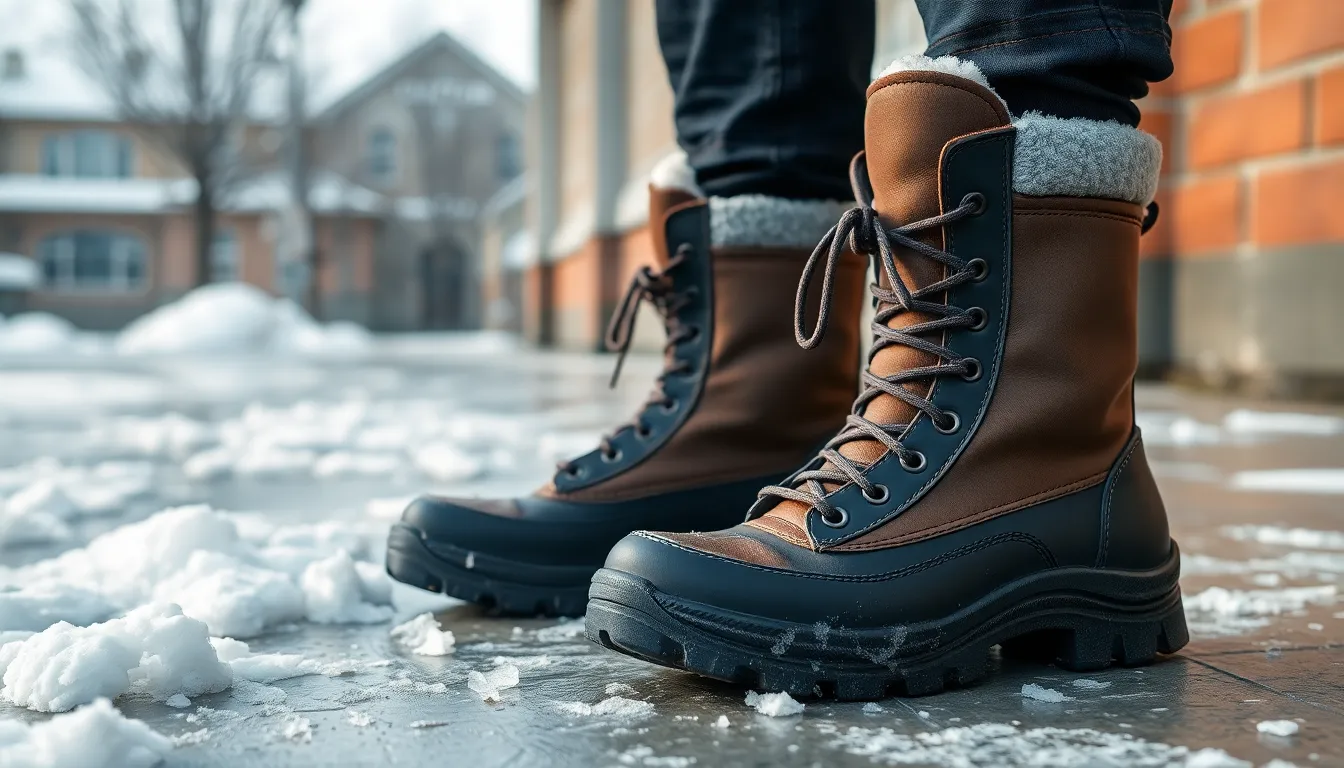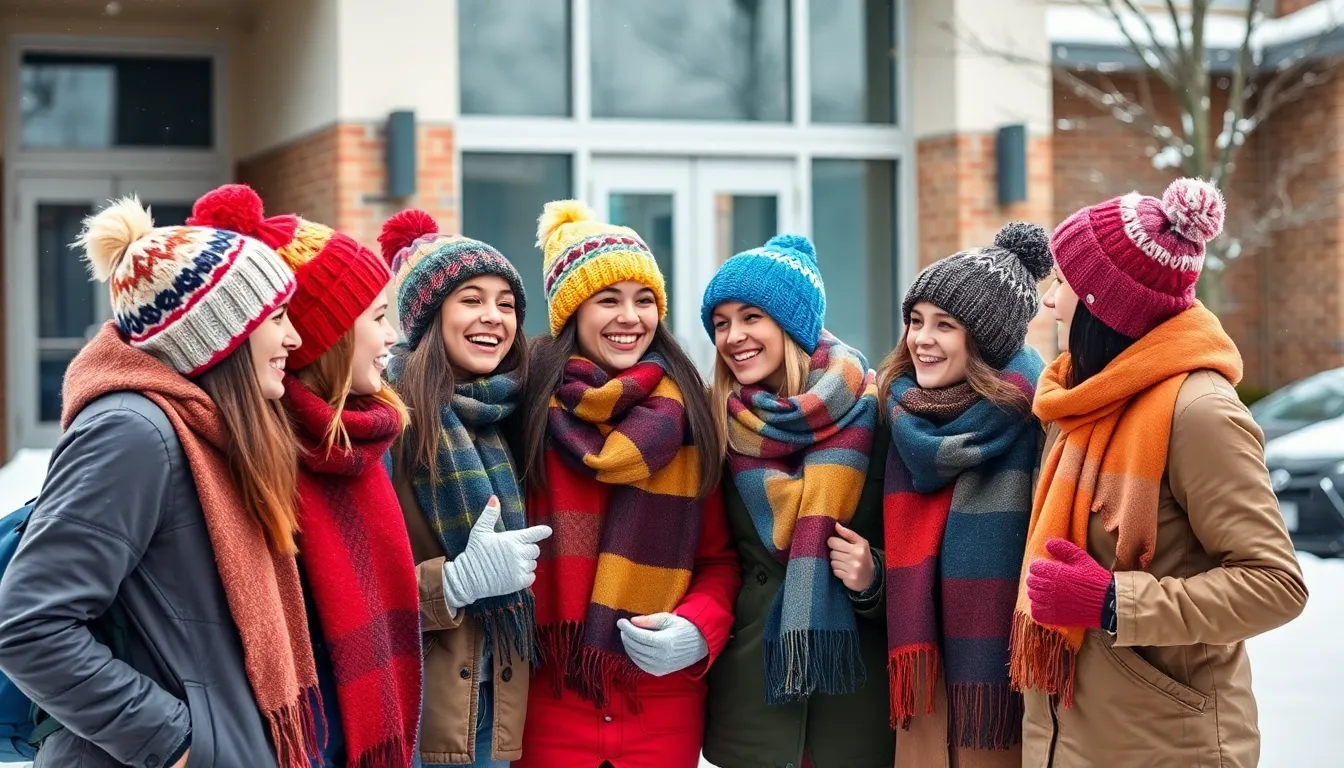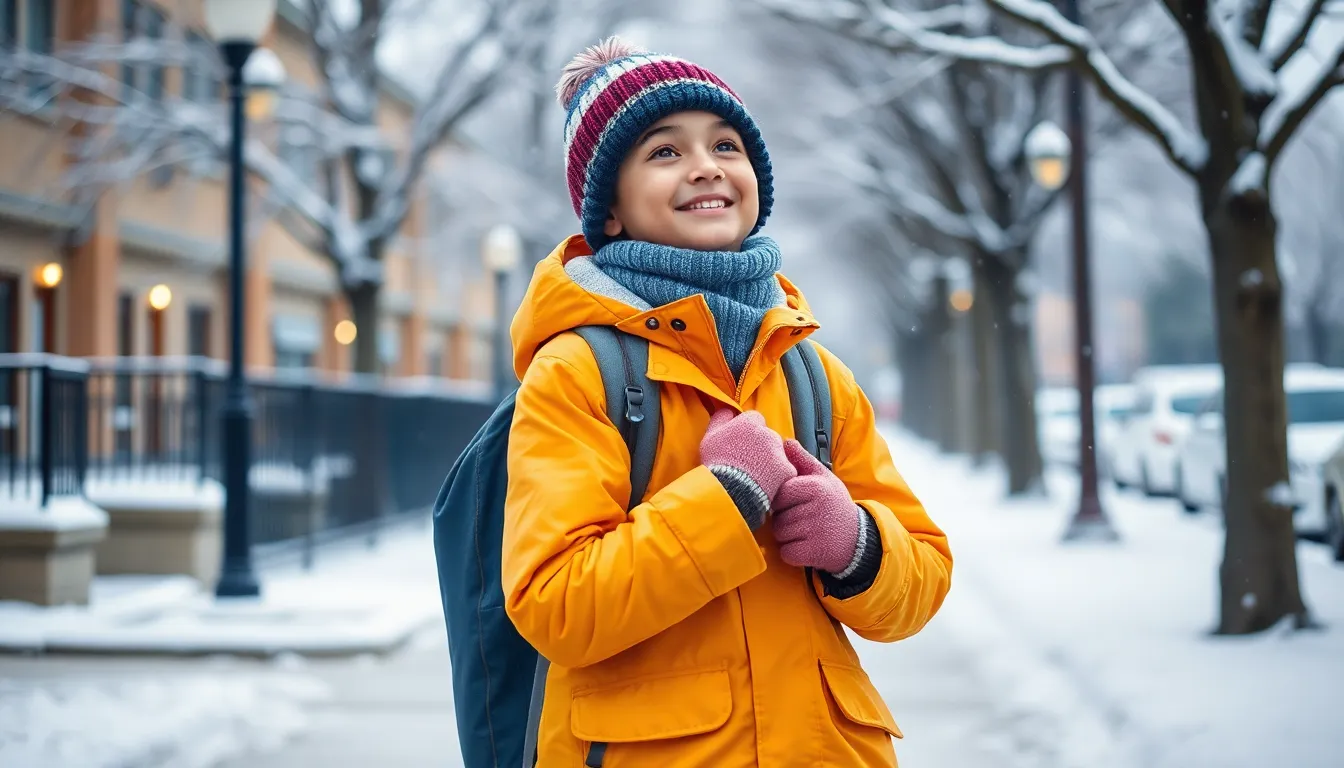Winter mornings can turn getting dressed for school into a daily challenge. We’ve all been there – staring at our closets wondering how to stay warm without sacrificing style or comfort during those long school days.
The key to mastering winter school fashion lies in strategic layering and choosing pieces that work both indoors and outdoors. We need outfits that’ll keep us cozy during the walk to school but won’t leave us overheating in heated classrooms. From waterproof boots that actually look good to sweaters that don’t make us look like walking marshmallows, there’s definitely an art to winter school dressing.
Whether you’re dealing with snow, rain, or just bitter cold temperatures, we’ll show you how to create versatile winter outfits that keep you comfortable and confident throughout your entire school day. Let’s jump into the essential pieces and styling tricks that’ll make your winter wardrobe both practical and fashionable.
Layer Your Base With Moisture-Wicking Fabrics
Building a solid foundation starts with selecting the right base layer that keeps you dry and comfortable throughout long school days. Moisture-wicking fabrics pull sweat away from your skin, preventing that clammy feeling when you move between heated classrooms and cold outdoor areas.
Choose Thermal Underwear for Extra Warmth
Thermal underwear serves as your first line of defense against winter’s harsh temperatures. We recommend merino wool thermals because they naturally regulate body temperature while wicking moisture away from your skin. Synthetic options like polyester blends also work well, offering excellent moisture management at a more budget-friendly price point.
Fitted thermal tops and bottoms create a smooth silhouette under your regular clothes without adding bulk. Look for thermal sets with flat seams to prevent chafing during active school days. Popular brands like Smartwool and Patagonia offer lightweight thermal underwear that’s perfect for students who need warmth without restriction.
Consider the weight of your thermal underwear based on your local climate and activity level. Lightweight thermals work best for moderate cold, while midweight options provide extra insulation for harsh winter conditions.
Select Cotton Blends for Comfort and Breathability
Cotton blends offer the perfect balance of comfort and practicality for school wear. We suggest choosing fabrics that combine cotton with moisture-wicking synthetic fibers like bamboo or modal. These blends provide the soft feel of cotton while maintaining better temperature regulation throughout the day.
Long-sleeve shirts made from cotton polyester blends work exceptionally well as base layers. They’re machine washable, affordable, and comfortable against your skin for extended wear. Target fabrics with at least 10% synthetic fiber content to ensure proper moisture management.
Avoid 100% cotton base layers in winter because they retain moisture and take longer to dry. Cotton blends with moisture-wicking properties keep you comfortable during temperature changes between classrooms, hallways, and outdoor activities. Choose neutral colors like white, gray, or black to ensure your base layers remain invisible under lighter-colored clothing.
Select Versatile Outerwear for Changing Temperatures

Building on your base layer foundation, we need outerwear that adapts to winter’s unpredictable temperature swings. Smart outerwear selection ensures we stay comfortable whether we’re walking to school in freezing conditions or sitting in overheated classrooms.
Invest in a Quality Winter Coat or Parka
Quality insulated winter coats serve as our primary defense against harsh winter conditions. We should prioritize coats with waterproof and wind-resistant features that provide extra protection during snow and rain storms. Insulation technology in modern parkas maintains warmth without excessive bulk, making them ideal for daily school wear.
School uniform guidelines often dictate acceptable coat colors and styles, so we must verify these requirements before purchasing. Many schools specify that winter coats display school logos or adhere to particular color schemes. Durability becomes crucial since we’ll wear these coats daily throughout the winter season.
Temperature ratings help us choose appropriate insulation levels based on our local climate conditions. We can select lighter insulation for milder winter regions and heavier options for areas with extreme cold temperatures.
Consider a Fleece or Hoodie for Mild Winter Days
Fleece pullovers and hoodies offer excellent warmth without the bulk of heavy winter coats. We find these mid-layer options perfect for days when temperatures hover around freezing or when indoor heating makes heavy coats uncomfortable. Removal becomes effortless when we transition from cold outdoor spaces to warm indoor environments.
School dress codes frequently allow fleece garments and hoodies as part of approved winter uniforms. Quarter-zip pullovers with school logos often meet uniform requirements while providing necessary warmth. These versatile pieces work well for layering over base layers or under heavier coats on extremely cold days.
Breathability in fleece materials prevents overheating during indoor activities while maintaining warmth during outdoor exposure. We can choose from various fleece weights depending on typical temperature ranges in our area.
Pack a Light Jacket for Indoor Temperature Control
Lightweight jackets provide essential temperature regulation in unpredictable indoor environments. We often encounter classrooms that feel either too cold or uncomfortably warm, making adjustable outerwear crucial for comfort. These jackets pack easily in backpacks and won’t take up excessive locker space.
Compatibility with school uniforms ensures our lightweight jackets meet dress code requirements throughout the day. Many schools permit uniform-compliant cardigans, light sweaters, or thin jackets as indoor layers. We can remove or add these pieces as needed without violating uniform policies.
Indoor temperature fluctuations occur frequently in school buildings due to varying heating systems and classroom occupancy levels. Having a lightweight layer ready helps us maintain comfort during these temperature changes without the bulk of heavier outerwear.
Choose Footwear That Handles Snow and Ice

Winter footwear decisions can make or break our school day comfort and safety. We need to select shoes that protect against moisture, provide stability on slippery surfaces, and keep our feet warm throughout the day.
Wear Waterproof Boots for Snowy Conditions
Waterproof boots are essential for snowy school days because they prevent moisture from seeping into our shoes and soaking our socks. We reduce the risk of frostbite and discomfort by keeping our feet completely dry during winter weather conditions.
Snow boots with sealed seams and waterproof materials like rubber or treated leather provide the best protection against wet conditions. We should look for boots with insulation ratings appropriate for our local climate to ensure adequate warmth retention. Tall boot styles that extend above the ankle offer additional protection when walking through deeper snow or slush.
Select Shoes With Good Traction for Icy Walkways
Shoes with good traction minimize slips and falls on icy school walkways and sidewalks. We need footwear with deep treads or textured soles that grip frozen surfaces effectively during winter commutes.
Rubber outsoles with aggressive tread patterns provide superior grip compared to smooth leather or plastic soles. We can identify quality traction by examining the sole design for multidirectional lugs and grooves that channel away moisture. Some winter shoes feature specialized ice grips or studs that deliver enhanced stability on particularly slippery surfaces.
Pack Extra Socks to Keep Feet Dry
Extra pairs of socks are crucial backup protection when our feet get wet during winter school days. We should always carry spare socks in our backpacks to change into if moisture penetrates our footwear.
Wool socks are especially recommended because they provide insulation, retain warmth even when damp, and are more durable than cotton alternatives. We maintain body heat and prevent cold-related foot ailments by keeping our feet consistently dry throughout the school day. Merino wool socks offer the best combination of warmth, moisture management, and odor resistance for extended wear during winter activities.
Accessorize With Essential Winter Gear

Winter accessories complete our layered winter school outfits by protecting exposed areas that lose heat rapidly. Strategic accessory choices ensure we stay comfortable during outdoor activities and morning arrivals.
Add a Warm Hat or Beanie to Retain Body Heat
Warm hats prevent important heat loss through our heads during cold winter mornings. We recommend choosing beanies made from wool or fleece materials that trap warm air close to the scalp. Knitted caps with thermal linings provide extra insulation for extremely cold climates.
School-appropriate colors like navy, black, or gray typically comply with uniform policies while offering versatility. Beanies with ribbed cuffs create a snug fit around the forehead and ears. We suggest selecting styles that won’t mess up our hairstyles when removed indoors.
Wear Gloves or Mittens for Hand Protection
Gloves shield our hands from freezing temperatures during outdoor school activities and walks between buildings. We find that mittens often provide more warmth than gloves since fingers share heat in the enclosed space. Thermal gloves with moisture-wicking linings keep hands dry and comfortable throughout the day.
Touchscreen-compatible fingertips allow us to use phones and tablets without removing gloves entirely. Waterproof or water-resistant materials protect against snow and slush during recess or lunch breaks. We recommend keeping an extra pair in our backpacks for backup protection.
Include a Scarf for Neck and Face Coverage
Scarves provide essential protection for our neck and lower face areas against harsh winter winds. We suggest choosing scarves made from wool or fleece that offer warmth without excessive bulk under our winter coats. Longer scarves allow multiple wrapping techniques for adjustable coverage levels.
Wind-resistant materials help shield our faces from frost and cold air during morning commutes. Neutral colors coordinate well with various uniform combinations while meeting school dress code requirements. We can easily remove scarves when entering heated buildings and store them in lockers or backpacks.
Plan School-Appropriate Outfits That Follow Dress Codes

Successfully planning winter school outfits requires understanding your institution’s guidelines while maintaining warmth and style. We’ll help you navigate dress code requirements while staying comfortable in cold weather.
Check Your School’s Winter Clothing Policies
Review your school’s student handbook for exact winter clothing guidelines before selecting outfits. Many schools permit coats and jackets in designated colors or styles that align with uniform requirements. Face coverings like ski masks may be prohibited as they obscure identification, so we recommend checking these restrictions beforehand.
Outerwear policies vary significantly between institutions. Some schools allow jackets and boots to be worn in classrooms, while others require removal upon entering buildings. Blankets typically aren’t permitted in classroom settings, making proper layering essential for maintaining warmth indoors.
Balance Warmth With Professional Appearance
Layer strategically to maintain professional standards while ensuring adequate warmth throughout the school day. Start with fitted base layers that provide insulation without creating bulk under uniform requirements. Sweaters and sweatshirts work effectively when they match approved school colors or fall within dress code parameters.
Professional appearance doesn’t mean sacrificing comfort in winter conditions. Choose durable, solid colored pants or skirts that meet school guidelines while providing necessary coverage. Leggings can be worn under skirts or dresses when permitted by your institution’s policies.
Coordinate Colors for a Put-Together Look
Select clothing colors that align with your school’s uniform requirements for a cohesive appearance. Solid colored options typically meet most dress code standards and create cleaner lines than patterns or graphics. We recommend sticking to approved color palettes when selecting sweaters, pants, and accessories.
Footwear coordination plays a crucial role in maintaining professional standards. Clean gym shoes or appropriate winter boots should complement your overall outfit while meeting safety requirements. Simple accessories like solid colored socks or tights help maintain visual consistency throughout your winter wardrobe choices.
Prepare Weather-Appropriate Indoor Clothing

Indoor winter comfort requires strategic planning since most schools maintain consistent heating throughout the day. Our clothing choices need to accommodate the transition from cold outdoor temperatures to warm indoor environments.
Dress in Removable Layers for Heated Buildings
Layering becomes essential when entering buildings with central heating systems. We recommend starting with a long-sleeve shirt as your base layer to provide immediate warmth upon arrival while preventing overheating as temperatures rise indoors. Medium-weight options like pullovers, hoodies, or light sweaters work perfectly as mid-layers since they’re easily removable when classroom temperatures fluctuate.
Fleece jackets serve as ideal mid-layers due to their exceptional warmth and breathability combination. These garments allow us to quickly adjust our comfort level by adding or removing layers throughout the school day. Thermal tops or moisture-wicking long-sleeve shirts help retain body heat during outdoor transit while remaining comfortable once we’re inside heated buildings.
Choose Breathable Fabrics for All-Day Comfort
Breathable materials prevent sweat accumulation and maintain comfort during extended wear periods. We should select clothing made from moisture-wicking fabrics that help regulate body temperature and promote better air circulation throughout the day. Cotton, wool, and exact synthetic blends offer superior temperature regulation compared to non-breathable alternatives.
Moisture-wicking properties become particularly important when transitioning between different temperature zones. These fabrics pull perspiration away from our skin and allow it to evaporate quickly, preventing the clammy feeling that can develop when wearing non-breathable materials in heated environments.
Keep a Light Sweater for Air-Conditioned Classrooms
Light sweaters provide essential backup warmth for classrooms with air conditioning or unpredictable temperature control. We can easily stow these garments when rooms warm up and quickly access them when temperatures drop unexpectedly. This extra layer proves invaluable during temperature shifts that commonly occur in school buildings throughout the day.
Carrying a lightweight sweater ensures we’re prepared for varying classroom conditions without the bulk of heavier outerwear. These versatile pieces can be tied around our waist or stored in backpacks when not needed, making them practical answers for indoor temperature management.
Pack Smart for Weather Changes Throughout the Day

Winter weather’s unpredictability means we need to prepare for conditions that can shift dramatically throughout a single school day. Smart packing strategies help us stay comfortable from morning commute to afternoon dismissal.
Carry a Weather-Resistant Backpack
Waterproof materials protect our books and supplies from snow or rain during commutes. We should invest in backpacks made from water-resistant fabrics like nylon or polyester with sealed seams to keep electronics and papers dry. Quality zippers with storm flaps prevent moisture from seeping through closures. Reflective strips on backpacks improve visibility during darker winter months when we’re walking to school early or leaving late.
Include Emergency Weather Items
Small essentials like gloves, hats, scarves, and hand warmers fit easily in backpacks to accommodate sudden weather changes. We can pack lightweight fleece gloves that compress into small spaces and provide warmth when temperatures drop unexpectedly. Compact knit beanies take up minimal room while offering crucial head protection against wind and cold. Disposable hand warmers activate quickly and provide hours of warmth during outdoor activities or long waits for transportation.
Plan for After-School Activities and Transportation
Appropriate outerwear and footwear for walking or waiting for buses in cold weather requires strategic planning. We need boots suited for snow or rain that prioritize both warmth and compliance with school shoe policies. Insulated winter boots with good traction prevent slips on icy walkways while keeping feet warm during extended outdoor exposure. Extra pairs of socks in our backpacks ensure dry feet throughout the day, particularly important for students who walk long distances or participate in outdoor sports after school.
Conclusion
Winter school dressing doesn’t have to be a daily struggle between staying warm and looking put-together. We’ve covered all the essentials to help you master this seasonal challenge with confidence.
Remember that successful winter school outfits start with smart planning and the right foundation pieces. When you invest in quality base layers waterproof footwear and versatile outerwear you’re setting yourself up for comfortable days regardless of what winter throws your way.
The key is finding that sweet spot where warmth meets school dress code requirements. With these strategies in your arsenal you’ll never have to choose between being comfortable and following school guidelines again.
Stay warm stay stylish and make this winter your most comfortable school season yet!
Frequently Asked Questions
What are the best base layers for winter school outfits?
The best base layers are made from moisture-wicking fabrics like merino wool or synthetic blends. These materials keep you dry and comfortable while providing warmth without bulk. Fitted thermal tops and bottoms create a smooth silhouette, and cotton blends offer good breathability. Avoid 100% cotton as it retains moisture, and choose neutral colors to keep base layers discreet under clothing.
How do I choose the right winter coat for school?
Select a quality insulated winter coat or parka with waterproof and wind-resistant features. Check your school’s uniform guidelines for acceptable colors and styles. Consider temperature ratings based on your local climate to ensure appropriate insulation levels. For milder days, fleece pullovers and hoodies work well as mid-layer options that comply with most school dress codes.
What type of winter footwear is best for school?
Choose waterproof boots made from rubber or treated leather with appropriate insulation ratings for your climate. Ensure shoes have good traction with deep treads or specialized ice grips to prevent slipping on icy walkways. Pack extra pairs of wool socks, especially merino wool, to maintain warmth and dryness throughout the day.
What winter accessories should I wear to school?
Essential winter accessories include warm hats or beanies made from wool or fleece, gloves or mittens for hand protection, and scarves for neck coverage. Choose versatile colors and materials that comply with school uniform policies. These accessories protect exposed areas that lose heat rapidly while maintaining a polished, school-appropriate appearance.
How do I dress for both outdoor cold and indoor warmth at school?
Use strategic layering with removable pieces. Start with a moisture-wicking base layer, add a medium-weight pullover or light sweater as a mid-layer, and bring a lightweight jacket for temperature control. Choose breathable fabrics to prevent overheating indoors, and keep a light sweater handy for air-conditioned classrooms or unexpected temperature changes.
What should I pack in my school bag for winter weather?
Use a weather-resistant, waterproof backpack to protect books and supplies. Pack emergency items like extra gloves, hats, and hand warmers for sudden temperature drops. Include extra pairs of socks and plan appropriate gear for after-school activities. Consider insulated boots with good traction and ensure all items comply with school policies.
How do I balance school dress codes with winter warmth?
Review your school’s winter clothing guidelines, as policies vary between institutions. Balance warmth with professional appearance by selecting fitted base layers and coordinating colors that align with uniform requirements. Choose solid-colored options for a cohesive look, and ensure footwear complements your outfit while meeting safety standards for winter conditions.







